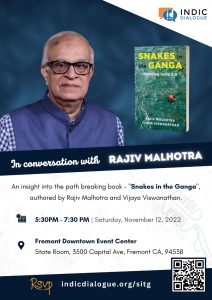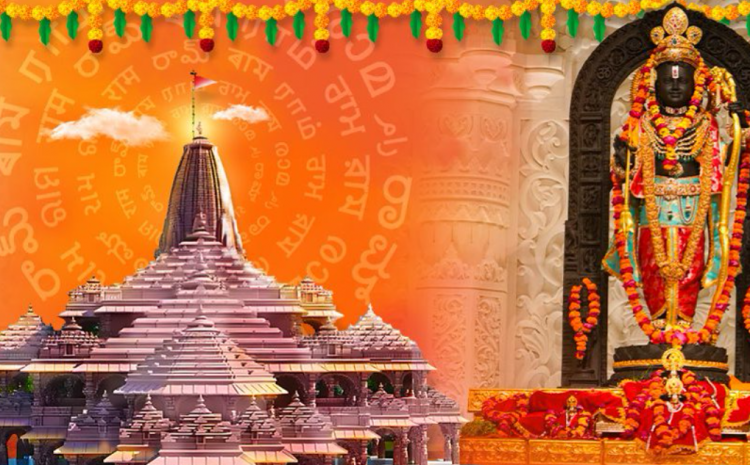
The Return of the Ram Janma Bhumi Mandir and its “RAM-ifications”
By Jeffrey Armstrong | Kavindra Rishi
On January 22, 2024, India’s Prime Minister Narendra Modi inaugurated the Ram Janma Bhumi Mandir in Ayodhya. Ayodhya was already an important pilgrimage site in the Indian state of Uttar Pradesh. All of India was abuzz for months with commentaries from all sides of the media. Globally, the event was known by the 29 million excited Indian NRI’s (non-resident Indians) who live outside of India. According to the Ministry of External Affairs, Indians comprise the world’s largest overseas diaspora. Yet this grand event, hosting 500,000 guests on the first day alone, was for the most part ‘missed’ by the Western media.
Nonetheless, in 2024, India cannot be underestimated. Globally, India has a huge economic and political influence, about which anyone can read in the many reports from experts in various fields. In addition, there are over 100 million non-Indian Yoga practitioners around the world who are benefiting daily from Yoga in its many forms, which also includes: Ayurvedic medicine, Jyotish/Vedic Astrology, and all of this with no funding from the government of India.
This article is being written to illuminate the importance of the return of the “Ram Mandir”, to both appreciative Western audiences and skeptics alike, by shedding light on its profound meaning and universal resonance within India’s rich tapestry of beliefs, its ancient heritage, and its profound and inclusive worldview.
“This is an opportunity to explain this to the world. The Ram Janma Bhumi temple in Ayodhya is just the next step in India’s global Vedic cultural renaissance.” Jeffrey Armstrong CNN India Interview
As India (whose proper name is Bharata) is reclaiming and in detail explaining its rich history, and vast library of ancient knowledge, the world is witnessing the next steps in a modern Renaissance of the Sanskrit Vedic Sanatana Dharma culture of Bharat, as it reawakens after hundreds of years of violent colonization.
The ancient Ram Mandir was destroyed by Islamic invaders in the early 1500s, and in 1528 the Muslims forcibly rebuilt a mosque in its place. Now finally, after 500 years of tyranny, controversy, and extended legal battles, the sacred building has been rebuilt, and restored, and its profound message reawakened, through the efforts of the many dedicated persons who cherish its ancient and profound cultural message and human significance.
This newly restored temple, the Ram Janma Bhoomi Mandir, is dedicated to honoring the Avatars of the Supreme Beings—named Sita and Ram—who according to Vedic history, appeared on our planet 14,000 years ago. As the lamps of the Ram Mandir are relit, they stimulate a global reawakening of the ancient concept of Purna Avatars—the complete descent to Earth of the Supreme and Ultimate Beings, the Source of all in both masculine and feminine forms. The renewal of this ancient Mandir has, for the first time, propelled its existence into the international spotlight, sparking discussions among millions of persons who are still unfamiliar with the historical significance of the descent of Ram and Sita to Earth (Mata Bhumi) and the meaning of the concept of Purna Avatars. This temple is unique because it marks the appearance of Shri Ram in the form known as Ram Lalla.
We extend a warm welcome and offer our greetings with “Namaste!” This expression signifies our reverence for you, dear readers, recognizing each of you as a unique, eternal, and immortal individual—an ‘atma’ in Sanskrit. We assure you that we will uphold the values of respect inherent in the Vedic tradition and never impose this worldview upon you by force. Allow us to elaborate further…
The Vedic culture rests upon a vast library of thousands of sacred Sanskrit texts, including the two epic historical stories known as the Ramayana and the Mahabharata. Recent scientific research on historical dating, conducted by Vedic Scholar Nilesh N. Oak and other investigators, places the Ramayana at 14,000 years ago and the Mahabharata at 7,000 years ago. These dates are not arbitrary but were determined through astronomical data embedded within the texts in the precise Sanskrit language.
In Sanskrit, these texts are referred to as itihasa, which means “as it actually occurred”. They are actual history, not mythology (a false teaching) as many would like the world to think. This Vedic history is usually opposed by Western scholars who are either covertly promoting the “Judeo Christian” worldview or are just opposed to the Vedic worldview, and who call it disparagingly a mythology, implying that it is false. In fact, the Sanskrit language gave rise to our English word “history” which is merely a distorted pronunciation of the Sanskrit word itihasa.
The two epics reveal the details of two historical eras when both the male and female forms of the Supreme Beings descended to Earth and lived long, precisely articulated, and well-recorded lives. Those two Supreme couples, the “Purna (complete) Avatars”, appeared on Earth twice and were present at very dramatic moments in world history, the details of which were carefully recorded in the Ramayana (Sita & Ram) and the Mahabharata (Radha & Krishna).
Vedic itihasa reveals that the Supreme Beings, descending from a higher realm of existence where they permanently reside, periodically appear on our Earth planet (whose Sanskrit name is Mata Bhumi) with the aim of benefiting humans in various ways: by leaving behind a worldview and an understanding that empowers us to perfect who we truly are and by imparting to us the knowledge of what the final goals and purposes of life are, including the ultimate destination of human existence.
To grasp the significance of the Ram Janma Bhumi Mandir, one must understand the message and purpose of the epic tale of the Ramayana. The Ram Mandir stands as more than just a structure; it is a beacon, guiding humanity towards the sacred Yogic lifestyle revealed by Shri Ram and Sita. Their legacy also offers the Ultimate and Universal principles of Bhakti Yoga for those who are willing to wholeheartedly accept and embrace them.
At this point, if you have read carefully, you should be thinking: “Are you implying that the Supreme Being is in fact the Supreme Beings as a couple, both male and female, who appeared twice on Earth, 14,000 and 7,000 years ago in the land of Bharata and who, through the way they lived and by what they taught, revealed to and instructed human beings in a science called Bhakti Yoga?” Yes, that is the Vedic message!
Bhakti Yoga teaches that we are undying and immortal atmas who are only temporarily inhabiting a material body, who have always existed and who will always continue to exist beyond our current physical body, and that by remembering our ability to have a permanent, loving relationship with the Supreme Beings, in their immortal forms as Sita and Rama or Krishna and Radha, we can perfect our human existence.
In the Vedic tradition, acceptance of its worldview and participation in its rituals are choices made willingly. It is crucial to understand that this worldview is never to be imposed upon anyone but rather is embraced by those who seek ultimate enlightenment and Ultimate self-knowing. The practice of devotional Yogic rituals, and practices, performed at home or in public Mandirs is always a personal decision, a choice that is never enforced or coercive, and that always fosters understanding and harmony rather than posing a threat to others.
Understanding the meaning of the installation of a Murti
Places like the Ram Janmabhoomi Mandir are gathering places dedicated to initiating, cultivating, developing, practicing, and perfecting a Yoga of Divine and loving relationship. The installation of a Murti or Deity in a mandir is a life-like reminder of the personal relationship potential that each of us is capable of having. Just as we place pictures of our loved ones around the house, in ancient times and today, larger than life-sized representations of the Divine persons are placed all over Bharat so that we may never lose sight of the Divine. On January 22, 2024, a murti of Shri Ram as a 5-year-old child (Ram Lalla), carved by Arun Yogiraj, was installed in the heart of this mandir commemorating the place where Ram descended to Earth as an Avatar. An Avatar is not “born” like the rest of us humans—rather, they purposely descend and are outside of the cycle of birth and death (samsara). Ayodhya is the city where Ram ‘appeared’ and as such, marks an important place for the practitioners of Sanatana Dharma (Hindus) and is a sacred place of which all citizens of Bharat can be proud. This installation or “Pranapratishtha” effectively means to invite Divine energy to sanctify the mandir and in this case, with the presence of Ram Lalla.
The Ram-ification of Sacred Words
To fully comprehend the profound significance and purpose of a sacred site like the Ram Janmabhoomi Mandir, one must look more deeply into the true meanings of a few commonly distorted English words and learn a few precise Sanskrit words that may be unfamiliar to many English speakers.
Any well-educated English-speaking person knows that in the early stages of the development of the English language, thousands of Latin words were inserted into the coarse and unrefined English tongue so that it could be spoken with more precision and therefore be used to develop various exacting sciences. But a very important linguistic fact, that almost no English users are aware of, is that both the Greek and Latin languages were derived from Sanskrit—the most precise and perfected language on our planet with over 4,000 precise grammatical rules.
God does not have enough meaning to be a synonym for Bhagavan
Here’s an example of a Sanskrit term that made its way into English long ago, and yet its origins as a Sanskrit word remain unknown. Even though it is widely used as an English word it does not have a precise definition. Ask anyone and you will get different and imprecise answers from each of them! That English word is “God”. God came into English from the Dutch word Guut, which was derived from the German term Ghutam, which is directly from the Sanskrit word Hutam, which means “the smoke arising from a Vedic ritual called the agnihotri yajna; a ceremony in which food is offered with gratitude into the fire as an offering of appreciation to the Supreme Beings and to all the Devas and Devis who conducted the Laws of Nature which helped to grow the food.” In the Bhagavad Gita, Krishna gives a long list of who He is, and among the others, in verses 4:24 and 9:16, 11:19 and 17:28, the text reads… “I am the Hutam”.
To clarify: the English word ‘God’ literally refers to the smoke rising to the sky as an offering of gratitude to various Divinities, including the Ultimate Divine Being, in a Vedic ritual called in Skt. a yajna. It is ironic that Christians, unaware of these Vedic practices, also express gratitude to God, yet perceive the Vedic culture as ‘pagan,’ which is by the way a mispronunciation of “Bhagavan” the ultimate Sanskrit name for the Being Who is the Source of everything.
Now for the Sanskrit term Bhagavan: Bhagavan is constructed of two terms: bhaga and van. According to the Sanskrit dictionary, there are six bhagas, which are unlimitedly desired and sought by all: beauty, wealth, strength, fame, knowledge, and detachment. The word van means to own and possess. So, the one who has all these qualities to an unlimited degree has the title of Bhagavan and his female counterpart is given the honorific of Shri or Shree. Her name always appears first, as in Bhagavan Shri Ram and Bhagavan Shri Krishna. In English, a van is a vehicle that holds our many possessions. So, you can see from this definition, that “Bhagavan” is not a synonym for the sloppy and imprecise term God (Hutam or sacred smoke), but rather it is the exact name for the Ultimate Persons and offers a precise definition of the unlimited qualities of those Supreme Beings.
With this, it should now be clear to the reader that in the culture of Bharat, temples like the Ram Janam Bhoomi Mandir are dedicated to connecting with the Supreme and Ultimate Being Shri Bhagavan in an inclusive and loving way. What is so special about the “Ram Lalla Mandir” is that it gives us access to the most endearing and loveable form of the Supreme Being. Remember how sweet and endearing a new baby appears and feels. The secret of the “Ram Janma Bhumi Lalla Mandir” is that nothing is sweeter, more loving, and endearing than the Supreme Being Shri Bhagavan, Shri Ram, appearing here on Mata Bhumi in the form of the sweetest child of all, who is infinitely and unlimitedly loving and loveable. Tell me, who could resist loving Sri Bhagavan in the form of a young child that you can imagine holding in your arms and loving with all your heart. One might wonder if the word “lullaby” came from lalla?
Much of my work as an author has been to decolonize and clarify the translations of Sanskrit words and texts into English. Similarly, there are many English words that are regularly used in the translation of Vedic texts that distort and undermine the meanings of the Hindu Vedic Sanatana Dharma Culture. Here I will bring to the reader’s attention just a few of the worst of such distorted English words.
Murti is not equivalent to the English word idol. Idol should never be used to describe the form of a Divine deity.
The first distorted English word is “idol” which is spoken of as if it is somehow wrong to use a carving in rock, a picture, or some kind of shape, as the representation of the Supreme Beings. But the English word “idol” is merely descended from the English word “idea” or “ideals” which is from the Greek word eidos, which means “that which is seen” or “to form an image or shape”. In a Vedic mandir, the murtis which may be carved out of stone are points of focus, ‘receiving’ our devotion as extensions or representations of the Supreme Beings, to whom we are making our heartfelt offerings of devotion. The Abrahamic religions do not condone or understand this process and to them, the word idol is a derogatory English term that is used to undermine Hindu culture by calling us idol worshipers – yet their idols are pop stars.
“Lord” Ram is not equivalent to Shri Ram
Another English word that is greatly misused and distorted is “Lord”. This word arose in Old English and referred to the landowners, who used slaves/serfs to work the land for growing grains which eventually became loaves of bread. The English word was “hlaff lady” and “hlaff lard” or “Lady” and “Lord”. This meant “maker of the bread”, and “protector and distributor of the bread”. The bread was used to pay the slave/workers, in the British caste system. If a slave did not work enough, they were called loafers. The Christian Lord’s prayer goes…Our father who are in heaven give us this day our daily bread…” Heaven is another word that is not synonymous with Swarga Loka.
This hierarchy combined with the illiterate vocabulary of the Christian church of England at that time used “Lord” to represent the ultimate ruler of the power-based system i.e., a Supreme male Lord. When England colonized Bharat by violence, they purposely imposed the word “Lord” upon the people they colonized and used it inappropriately in their translations of Vedic texts. In the Bhagavadgita, they renamed Shri Krishna “Lord Krishna” / Lord Ram instead of Shri Ram— thus removing the Feminine Divine—another concept they vehemently oppose—distorting the meaning by a so-called translation.
This Ram Mandir is a matter of National pride for all of Bharat India
We hope this explanation is an invitation to everyone to visit the Ram Janma Bhoomi Mandir and experience the celebration of the appearance of Shri Ram. May they live in our hearts forever and show us the way to bring shanti and peace to Mata Bhumi…Mother Earth.
Jeffrey Armstrong (Kavindra Rishi) was born into a Caucasian family and has now been a practicing Hindu for the last several decades teaching Vedic philosophy full-time.
Author / Poet / Relationship Expert / AyurVedic Astrologer / Keynote Speaker / Yogi / Philosopher, Jeffrey is a relationship expert, practitioner, and teacher of the Vedas for over 40 years. Prior to his teaching he had a successful career as an executive in Silicon Valley and spent five years in an ashram as a brahmacharya (monk). He is a sought-after guest expert on TV and talk radio. For 15 years, he was a corporate executive in Silicon Valley, and a speaker for Fortune 500 companies and was written about regularly in USA Today, the Wall Street Journal, LA Times, Huffington Post, CNN, Vancouver Sun, Hindu Today, and many others.
Jeffrey was recently awarded the ICCR Distinguished Indologist Award in 2021 from the Govt of India and the Lifetime Achievement Award in 2022 from the Canadian Hindu Chambers of Commerce. He is the author of the decolonized Bhagavad Gita Comes Alive. He has taught four seasons (108 episodes) of the Gita, and this learning community can be accessed through the Gita Comes Alive website.
His recent mystical poetry book titled “Dreaming the Countless Worlds” was released in 2022 by the Consul-General of India, Vancouver. Recently, he spoke at the BAPS Swami Narayan Akshardham Mandir opening in New Jersey (2023), and at the Ram Mandir Praan Pratishta event 2024 (CNN, Times Now, India Today, Hindustan Times). He is considered one of the foremost authorities on Vedic knowledge and Hindu Vedic Sanatana Dharma and its relevance to contemporary spirituality.



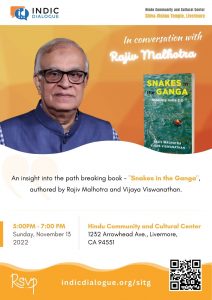
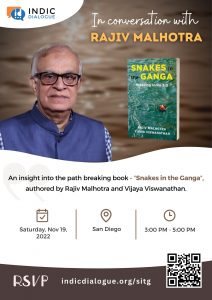
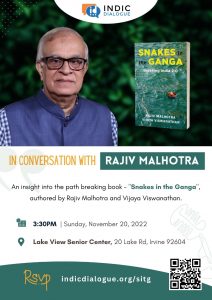 RSVP – IRVINE, CA
RSVP – IRVINE, CA